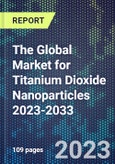Titanium dioxide (TiO2) possesses a higher refractive index than diamond, does not absorb visible rays, and is highly chemically stable. Therefore, it is widely used in paints and cosmetics as a white pigment and ultra-violet (UV) absorbing agent. There are three types of crystal structures of titanium dioxide-anatase, rutile and brookite. Industrially used ones are anatase and rutile. Rutile is the most stable, and anatase converts to rutile at temperatures in excess of 700 °C.
Microparticle titanium dioxide (TiO2) and nanoparticle Titanium Dioxide (TiO2-NPs) are markedly different materials. Micron particle size TiO2 is mainly used as a white pigment in the paint and cosmetic industry. TiO2-NPs possess a much greater surface area of a given mass or volume of nanoparticles compared to an equivalent mass or volume of conventional TiO2 particles, resulting in enhanced catalytic activity and UV absorption at certain wavelengths.
TiO2-NPs exhibit UV shielding effects, and rutile is widely used in the cosmetics sector, especially in sunscreens. Anatase displays photocatalytic functions (more so than rutile) and offers self-cleaning capabilities under sunlight, air cleaning, water quality improvement and anti-microbial and anti-mould functions for application in numerous paints and coatings sectors. Nano-porous TiO2 thin films have been widely used as the working electrodes in dye-sensitized solar cells (DSSCs). DSSCs consist of a sensitizing dye, a transparent conducting substrate (F-doped tin oxide), a nanometer-sized TiO2 film, iodide electrolyte, and a counter electrode (Pt or carbon).
Commercially available brands of TiO2-NPs vary in particle size, surface area, purity (e.g., due to doping, coating, or quality control), surface characteristics, crystalline form, chemical reactivity, and other properties. Photocatalytic paints and coatings (containing photo-active titanium dioxide (TiO2) as a white pigment) have been widely used in building protection due to the self-cleaning activity of TiO2, which effectively remove inorganic and organic pollutants as well as dirt and stains. Photocatalytic coatings are largely composed of nanoparticles of ceramic oxides, with most based on titanium dioxide (TiO2). Other types contan mixtures of TiO2 with silicon dioxide (SiO2) and/ or zinc oxide (ZnO). Tungsten oxides have found application in indoor photocatalysts activated by visible light.
Report contents include:
- Market drivers and trends.
- Properties and synthesis methods.
- Market segment analysis. Markets covered include Sunscreens and cosmetics (personal care products), Coatings, Biomedicine and healthcare, Ceramics and solar.
- Global market structure.
- Global regulations and safety.
- Price and price drivers.
- Market consumption of Titanium dioxide (TiO2) nanoparticles/powders, total, by market and by region.
- Profiles of 58 companies.
This product will be delivered within 1-3 business days.
Table of Contents
1 RESEARCH METHODOLOGY
Companies Mentioned (Partial List)
A selection of companies mentioned in this report includes, but is not limited to:
- Advanced Materials-JTJ s.r.o.
- Advanced Nano Products Co. Ltd.
- AM Technology Ltd. (Airlite)
- American Elements
- AVANZARE Innovacion Tecnologica S.L.
- CAN GmbH
- Cardinal Glass Industries
- Cinkarna Celje, D.D.
- Cristal/Tronox
- Croda International Plc
- DrivePur
- DSM
- Dupont
- Entekno
- Evonik Industries AG
- Green Earth Nano Science, Inc.
- Green Millenium, Inc.
- Green Resource Co., Ltd.
- Hangzhou Wan Jing New Material Co., Ltd.
- Heidelberg Cement
- Ishihara Sangyo Kaisha, Ltd.
- Italcementi Group
- Jiangsu Changtai Nanometer Material Co, Ltd.
- Joma International AS
- Kronos International, Inc.
- Life Air Iaq Ltd.
- MACOMA Environmental Technologies, LLC
- Maeda-KougyouCo, Ltd.
- Merck Performance Materials
- Mitsubishi Gas Chemical Company, Inc.
- MVX Protex
- Nanjing Emperor Nano Material Co., Ltd
- Nanjing High Technology Nano Material Co., Ltd. (HTNano)
- Nanotech Surface Company
- Nanowave Co., Ltd.
- Nanoyo Group Pte Ltd
- Nippon Sheet Glass Co., Ltd.
- NOF Corporation
- Pacific Paint (Boysen) Inc.
- Panahome Corporation
- PJI Contract Pte Ltd
- Pureti, Inc.
- Resysten
- Sachtleben Chemie GmbH
- Saint-Gobain Glass
- Sakai Chemical Industry Co., Ltd
- Shin-Etsu Chemical Co., Ltd.
- Showa Denko K.K.
- Sigma-Aldrich Corporation
- Taiyo Kogyo Corporation
- Tayca Corporation
- Titan Kogyo K.K.
- Toto
- Toyokosho Co., Ltd
- Toyota Tsusho Corporation
- Tri-K Industries, Inc
- Ube Exsymo Co., Ltd.
- Yield Co., Ltd.








